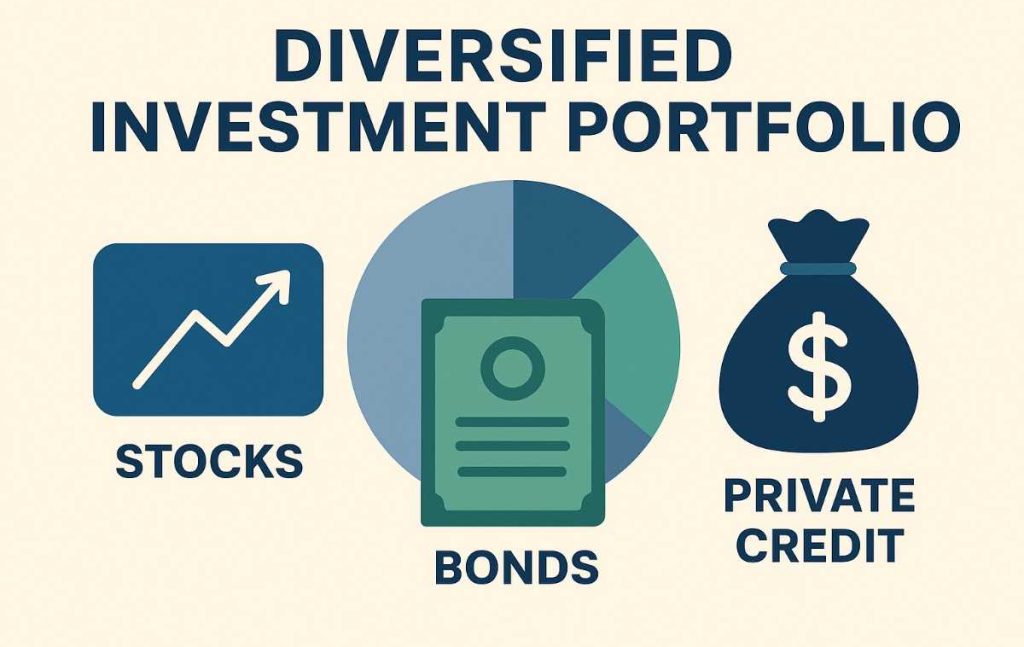Introduction: Why Private Credit Matters in 2025
In 2025, investors are paying closer attention to private credit 2025 as an alternative to traditional bonds. With interest rates remaining volatile and yields on government securities compressed, many are searching for higher income opportunities that don’t require extreme risk. Private credit also known as private debt has quickly moved into the spotlight, offering diversification, attractive returns, and new ways to participate in lending markets once reserved only for banks.
The rise of private credit reflects a fundamental shift in global finance. As traditional banks step back from lending due to stricter regulations, private lenders have stepped forward. This has created a landscape where individuals and institutions alike can tap into direct lending opportunities and enjoy yield premiums compared to public markets. But what exactly makes private credit different, and why does it matter now more than ever?
What Is Private Credit Investing?
At its core, private credit investing means providing loans directly to companies, projects, or funds outside of traditional banking channels. Instead of buying government or corporate bonds in public markets, investors allocate capital to private debt funds or directly finance businesses.
This investment class has gained traction due to its ability to offer alternative fixed income with attractive spreads over comparable bonds. It bridges the gap between equity investing and traditional debt, offering a compelling balance of risk and reward.
How It Differs from Bonds
While bonds are publicly traded and generally liquid, private credit loans are privately negotiated and not listed on exchanges. This makes them less transparent and harder to exit — but it also provides the illiquidity premium investors seek. In simple terms, investors earn higher yields in exchange for tying up their money for longer periods.
Another key distinction lies in structure. Bonds typically have standardized terms, while private loans are customized. This customization allows lenders to negotiate covenants, collateral, and interest rates in ways that better protect their capital.
Growth of Direct Lending & Private Debt Funds
Over the past decade, direct lending opportunities have exploded. Institutional players such as pension funds, insurance companies, and endowments are allocating billions into mid-market lending and private credit strategies. Private debt funds now manage trillions globally, reflecting the sector’s transformation from niche to mainstream.
By 2025, the trend is accelerating. With credit spreads 2025 widening in certain markets and banks pulling back, private credit funds are filling the financing gap for small and mid-sized businesses. This growth suggests that the market is not only expanding but also maturing into a permanent fixture of the global financial system.
Opportunities in Private Credit 2025
The main attraction of private credit is straightforward: higher yields than traditional bonds. But the opportunities go deeper than just returns.

Higher Yields & Illiquidity Premium
Investors who commit capital to private loans are often rewarded with an illiquidity premium — extra yield for accepting that their funds may be locked in for several years. In 2025, these premiums remain attractive, particularly compared to government and investment-grade bonds. For many investors, this yield boost is the primary reason to consider private debt.
Floating-Rate Advantage in Rising Rates
With interest rates 2025 still uncertain, floating-rate loans are a powerful advantage. Many private loans are structured with floating rates tied to benchmarks like SOFR or LIBOR replacements. This means investors can benefit when rates rise, unlike fixed-rate bonds that lose value in a higher-rate environment. For those concerned about inflation or monetary tightening, floating-rate private loans offer valuable protection.
Risks & Challenges for Investors
Of course, private credit is not without risks. Higher yields always come with trade-offs.
Default Risks & Transparency Issues
Unlike large public companies issuing bonds, many private borrowers are smaller firms with less financial history. This introduces default risks in private debt, particularly in economic downturns. In addition, the private nature of these deals means transparency is limited — investors may not have full visibility into company performance until challenges arise.
Liquidity Constraints & Market Downturns
Liquidity is another concern. Because private loans are not easily tradable, exiting positions before maturity can be difficult. In times of financial stress, this lack of liquidity can magnify losses. Market downturns may also lead to tightening credit conditions, raising the likelihood of defaults across portfolios. Investors must weigh whether the yield premium vs bonds is worth the reduced flexibility.
Comparing Private Credit vs Bonds
For investors considering whether to shift allocations from bonds into private credit, it’s helpful to compare the two side by side.
Yield Premiums & Risk-Adjusted Returns
On average, private credit offers yields several percentage points higher than traditional bonds. The additional return comes from factors such as illiquidity, complexity, and the smaller size of borrowers. When evaluated through the lens of risk-adjusted returns, private credit often looks compelling for investors willing to accept the unique risks.
Institutional Demand & Retail Access
Initially, private credit was dominated by institutional investors. Today, however, retail access is expanding through vehicles like interval funds, business development companies (BDCs), and even private credit ETFs. This democratization is opening doors for individual investors who previously couldn’t participate in the space.
Portfolio Strategies for USA, UK & Canada
Private credit can play different roles depending on an investor’s objectives.

Allocation Models for Conservative, Balanced & Aggressive Investors
Conservative investors may allocate a small slice (5–10%) to private debt funds for diversification without excessive risk.
Balanced investors might increase exposure to 15–20%, seeking a steady stream of income alongside traditional bonds and equities.
Aggressive investors may go as high as 25–30% in private credit, emphasizing yield and growth, but should remain mindful of liquidity challenges.
This flexibility makes private credit attractive across regions like the USA, UK, and Canada, where investors are increasingly seeking portfolio diversification beyond bonds and stocks.
Role of Private Credit ETFs & Alternative Funds
The launch of private credit ETFs and alternative funds has significantly expanded access. While they may not perfectly replicate the returns of direct lending, they provide liquidity and transparency. For many retail investors, these vehicles represent the most practical entry point into alternative assets growth within private credit markets.
“Beyond private credit, investors are also eyeing innovative sectors—our guide on AI in Healthcare Investing 2025 explores whether medical AI stocks can deliver long-term growth.”
FAQs
Is private credit 2025 safe for beginners?
Private credit can be suitable for beginners, but only with proper education. The higher yields are appealing, but risks such as defaults and illiquidity require careful consideration.
What returns can investors expect?
Returns vary widely, but private loans typically deliver a yield premium vs bonds of 3–5% or more, depending on structure and borrower quality. However, these are not guaranteed and depend on market conditions.
How liquid are private credit funds?
Liquidity remains limited. Most direct lending funds lock capital for several years. However, newer vehicles like private credit ETFs and interval funds are making access easier, though with slightly lower return potential.
Conclusion & Next Steps
Private credit in 2025 represents one of the most compelling opportunities for investors seeking higher yields and portfolio diversification. By offering alternatives to traditional bonds, it provides both income and growth potential. But the risks from illiquidity to defaults mean investors should approach with clear strategies and realistic expectations.
For those willing to embrace complexity, private credit can be a rewarding complement to traditional investments. As always, careful due diligence and diversification remain key.
Educational purposes only, not financial advice.

1 thought on “Private Credit 2025: Unlocking High-Yield Opportunities”